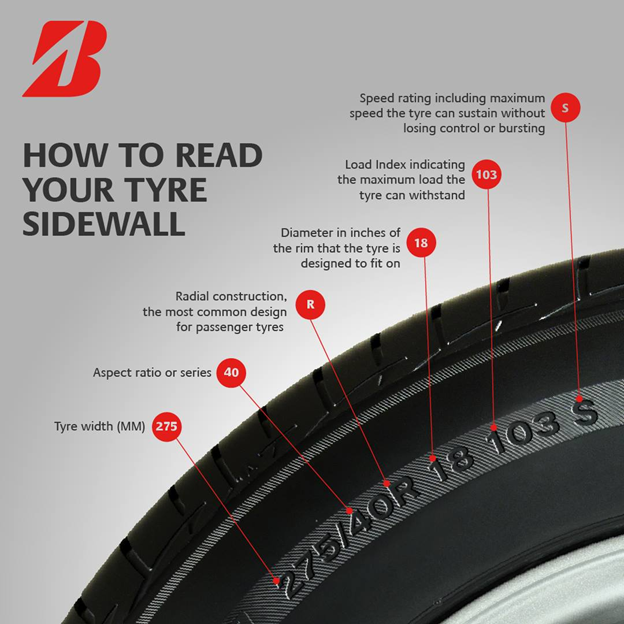Tyre Specifications: What They Mean and Why They Matter

Tyres come in various sizes, each designed for specific purposes. While size differences might be obvious at first glance, understanding the key specifications of your tyres requires a closer look. We’re sure you’ve seen the letters and numbers on the sidewall of your tyres, but, do you know what they mean? To the untrained eye, they can seem random and confusing. If you find these markings confusing, let’s clear the air and explain why they are more important they appear.
Reading Your Tyres
Recommended Use for Tyre
Most tyres are marked with the letter “P”, indicating that they’re meant to be used on passenger vehicles. This can include cars, SUV’s and light duty pickup trucks. Other letters you might encounter include:
· LT (Light Truck Type)
· T (Temporary)
· ST (Special Trailer)
Tyre Width
The first three numbers you’ll notice on your tyre indicate its width in millimeters. This measurement refers to the distance of one sidewall to another.
Aspect Ratio
The two numbers following the slash mark refers to the tyre’s aspect ratio. Expressed in percentages, this aspect ratio represents the height of the tyre’s sidewall relative to its width. For instance, if the number displayed is “70”, it means that the tyre’s height is 70% of its width.
Tyre Construction
Next up, you’ll notice a single letter that indicates the type of internal construction maintaining its stability. The two common types are:
· R (Radial Ply): The internal ply cords are designed in a radial direction
· D (Diagonal or Bias Ply): The internal ply cords form a criss-cross pattern
Rim Diameter
Following the tyre construction, you’ll notice two 2 numbers indicating the diameter of your tyre’s rim in inches.
Load Index
The next two numbers indicate your tyre’s load index, representing the maximum weight a tyre can support when its fully inflated. It’s important to note that these numbers don’t directly reflect the weight a tyre can support. Instead, they correspond to a specific load capacity listed in a standardised index and are only valid with proper tyre inflation.
Speed Rating
The final letter on the sidewall of your tyre is its speed rating, which denotes the maximum speed a tyre can safely handle. Like the image above, a tyre with the speed rating “S” is rated for speeds up to 180km/h. For more details, check out our article on tyre speed ratings, which discusses the common ratings at length.
Why Are Tyre Specifications Important?
Simply put, these markings on your tyre’s sidewall play a crucial role in ensuring your safety and the performance of your vehicle. Here’s how driving on mismatched tyres can lead to a significant tyre problem and impact your overall driving experience.
- Incorrect Width:
Tyres that are either too wide or too narrow can lead to a lack of driving stability, increasing the risk of fatal accidents.
· Mismatched Load Index:
Using tyres with a mismatched load index can increase the risk of tyre blowouts or even cause your vehicle to roll over.
· Wrong Aspect Ratio:
Tyres with a higher aspect ratio than recommended may adversely affect your vehicle’s handling.
· Different Rim Diameters:
Tyres with mismatched rim diameters will affect the braking, handling and stability of your vehicle, making it a potential safety risk.
· Varied Speed Ratings:
Tyres with mismatched speed ratings can affect your vehicle’s handling while also increasing the risk of a tyre blowout or faster tyre wear.
Now that you understand tyre specifications, you can start using this knowledge to make informed decisions for your vehicle. However, merely knowing these specifications alone isn’t enough to ensure safety and performance. The next step you can take is to form an organized tyre care routine, ideally practiced once a month to keep yourself and others safe on the road. And at Bridgestone, we’ve got an extensive catalogue of high-quality tyres suitable for a variety of driving styles and vehicles, all designed to enhance your driving experience.